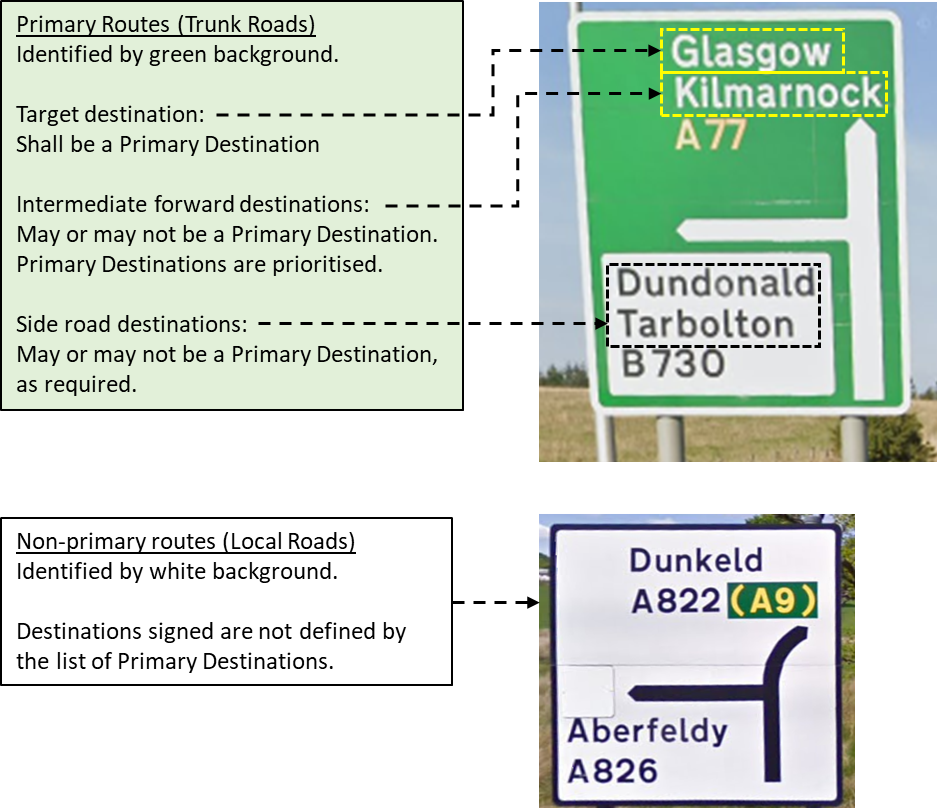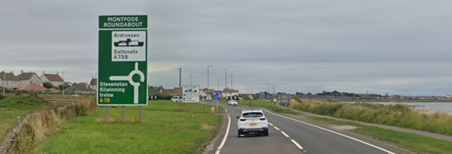Step 1 - Develop a clear understanding of your objectives
What are the objectives of the policy, strategy or service?
What are the intended impacts/outcomes and how do these potentially differ across the islands?
Transport Scotland proposes to update the list of “Primary Destinations” which are prioritised for trunk road direction signing. The list is currently published in Department for Transport circular LTN 1/94. The objective of these proposals is to align the list of Primary Destinations with the trunk road network, and reflect changes to the network which have developed since the list was last published in 1994. This will ensure clear guidance and consistency in signing the strategic trunk road (Primary Route) network.
It is emphasised that omission from the list of Primary Destinations does not prevent a location from being signed on or from the trunk road network. However it does prevent it from being identified as a “target destination” on the trunk road network, i.e. the forward destination identified at the top of a trunk road sign.
Figure 1 illustrates a typical PRN direction sign (green background), showing how the identification of a Primary Destination affects what is included on the sign. The target destination, displayed at the top, will be identified for each route or section of route, and will always be a destination that is listed as a Primary Destination. Intermediate forward destinations may or may not be listed as Primary Destinations, but Primary Destinations will be prioritised. Side road destinations may or may not be from the list of Primary Destinations, though where the side road is a trunk road it would be normal for the target destination on that route to be displayed.
Note that what is displayed on a non-primary route direction sign (white background) is not defined by the list of Primary Destinations.

Most of Scotland’s islands do not have trunk roads on them and are not directly affected in this way. However the ports that serve the islands are significant nodes on the transport network, and these are accessed by strategic trunk roads. Therefore appropriate trunk road signing to these ports is essential to accessing the islands.
The following cities, towns and villages in Scotland are on the existing list of Primary Destinations, and directly serve ferry services to Scotland’s islands. They also represent the end point of their relative trunk roads. The proposals would retain these as Primary Destinations, therefore there is no change relating to the signing of these listed destinations:
- Aberdeen (A90 and A96) – island destinations include Orkney and Shetland
- Mallaig (A830) – island destinations include Skye and South Uist
- Oban (A85) – island destinations include Mull, Barra and South Uist
- Thurso (for Scrabster) (A9) – island destination Orkney
- Ullapool (A835) – island destinations include Lewis and Harris
Island communities, particularly those located further south in Scotland, are also served by towns and villages which are located on the trunk road network (though not at an end point) and are not included on the existing list of Primary Destinations, most notably (but not exclusively) on the A78 which includes Ardrossan (for Arran), Wemyss Bay (for Bute) and Largs (for Cumbrae). Again, there is no proposal to change this situation and therefore no impact. It is noted that where the port is located close to the trunk road, as in these situations, the port can be adequately signed (with the inclusion of the ferry symbol where appropriate) without being on the list of Primary Destinations, as illustrated in the example at Ardrossan below.

There are no proposals to change the way that Scotland’s airports are signed on the trunk road network.
The Skye Bridge was opened in 1995, after the existing list was published. This resulted in the A87 trunk road being extended across the Isle of Skye to the port of Uig, which serves the ferries to Lewis and Harris and North Uist. Updating the list to reflect these changes in the network has been a key consideration in the proposals, and the only change that is considered to directly impact on signing to the islands. This is therefore further discussed in Step 2.
Road signing in the Gaelic language has significance to many of Scotland’s island communities, including Skye and the Western Isles. While the proposed changes to the list of Primary Destinations do not affect policy regarding Gaelic language road signing, there are implications which are considered here.